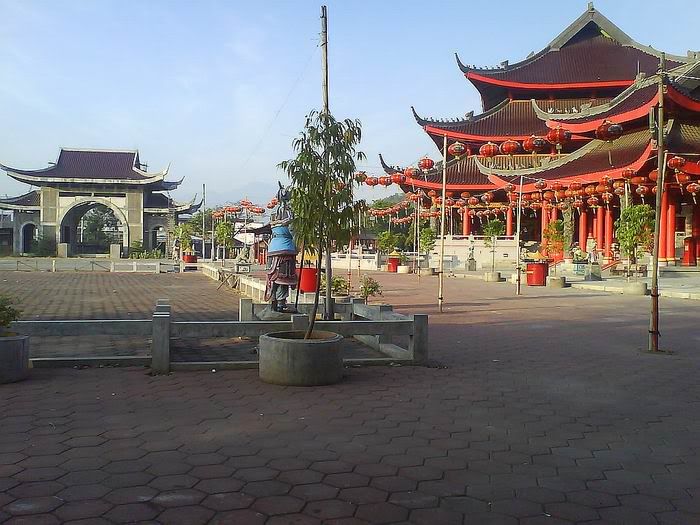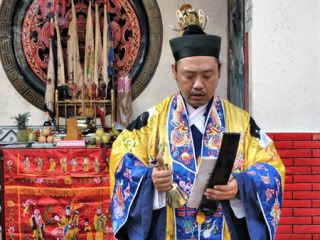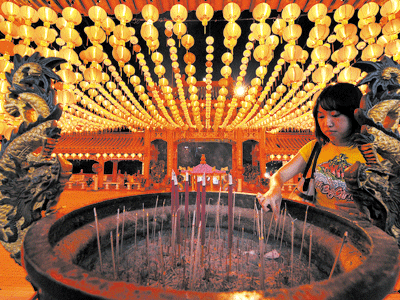
Lunar New Year is the most important celebration for the Middle Kingdom, as well as 1 Muharram for Muslims. Lunar New Year celebration begins on the first day of the first month in the calendar Tionghoa and ends with Cap Go Meh on the date to fifteen (at the time of full moon).
In China, customs and traditions associated with the region New Year celebration is very diverse, as well as in Indonesia. For those of you who are not descendants of Middle Kingdom, but wanted to celebrate, here we provide some spot areas in Indonesia who took part to celebrate Lunar New Year with a different characteristic.
1. Market Square and the Temple of Nine, Jakarta
This temple dominated the entire building is red and surrounded by a wall. The main door is in the South, a red dragon gate. The left side of the gate there is a row of three old temples. On the second page is the main temple follows South facing two lions (Gu Shi Bao) is said to have originated from Kwangtung Province, South China.
By the Lunar New Year, the temple has done trimming and re-paint it will never lonely visited by the visitors, especially Sino community will pray.
Ahead of Lunar New Year festivities also seen in some traditional markets are usually visited by people Indonesians, such as the Market Square opposite Nine Glodok electronic center in West Jakarta. It is sold in various markets dry sweets like kana, plum, and sweetened orange peel. Sweet tasting foods such as sweets and candies Sino trusted citizens as the symbol of life sweet.
There are also lots of typical Lunar sold fruit such as oranges, lychees, and plums. Citrus fruits, especially Mandarin oranges, and orange diborong Bali many buyers because of the orange fruit is considered a symbol of brotherhood and harmony.
2. Thousand Temple City, Singkawang, West Kalimantan
Singkawang every Lunar New Year celebrations and Cap Gomeh events held regularly on a large scale. There are five major events are often held as competitions as decorative lanterns Singkawang, art night was held on Lunar New Year night, a parade float, Cap Go Meh, and warm-hearted evening. In the float parade we can see Tatung, Loya, and Lion Dance.


In this city during the Cap Go Meh, we can watch the show Tatung. Tatung is a major media Cap Go Meh. Attractions Tatung filled with mystical and exciting, because many people possessed, and these people called Tatung. Unique in Singkawang many Dayak natives or people who also participated into Tatung, they were compelled to participate because of the ritual ceremonies like Tatung Dayak.
3. Shampoo Kong temple, Semarang
Stone Building Sam Po Kong is petilasan, former haven and the first landing of China's Admiral named Zheng Ho (Cheng Ho) or also known as Sam Po Tay Djien. This building is located in Simongan area, southwest of Semarang. Called the Stone House because of its shape in the form of large stone cave in the foothills of the rock. The building is now a memorial, prayer, and pilgrimage. In the cave there is a stone altar and statues of Sam Po Tay Djien.

On the night of Lunar New Year and Cap Go Meh people flocked to the Temple of the Stone Building Shampoo Kong. They have prayed, and many others had come to see various performances and puppet of the people since the night until early morning. There are many different vendors such as confectionary and lontong Cap Gomeh godhog wedang of peanuts, sugar cane, sekoteng, and round.
4. Phak Liang and Khak Vihara Dewi Kwan Im, Bangka
Second place is worth a religious history can be your choice for day trips and Lunar Cap Go Meh. Phak Liang Khak mute witness to the history of tin mining in Bangka who then made the tourist area filled with China-style buildings.
The location was in Belinyu, 57 Km from Sungailiat. In addition there Cok Grave Tien, daughter of Bong Kiung Fu, a figure who founded the China Kuto Bannerman Castle. This tomb was in the Citadel, 1.5 Km from the City Belinyu. While Dewi Kwan Im Vihara in Jelitik village, about 15 Km from the City Sungailiat, precisely at the foot of the hill the river flowed. Sino citizens there, the water is believed to menyebuhkan various diseases and can make youth. These objects are in bathing pool and a small temple to pray.
5. Tech Hay Kiong temple, Tegal
300-year-old temple this over stand on the land area 4500 square meters. This temple formerly named Cin Jin Bio. The name Hay Kiong Tech also means the Palace of Konco Tech Cin Jian Hay that is the title of greatness from Kwa Lak Kwee. For Tegal and surrounding communities, Konco Tech Cin Jian Hay revered as a patron god.



In this temple every year held a prayer ceremony include inviting beach with god temples in the sea from the town of Tegal Coast. Then Relay Toa Pe Kong where Tek Hay Kiong temple out of eight litters, prayers, musical / Tiong Guan, and the ceremony Sejit Cin Jin Tek Hay held a large scale to celebrate the first day of Tech Co. Hay Kong Cin Jin came to Tegal. (* / Ol-5)
 11:57 PM
11:57 PM
 ipoeLzone
ipoeLzone









